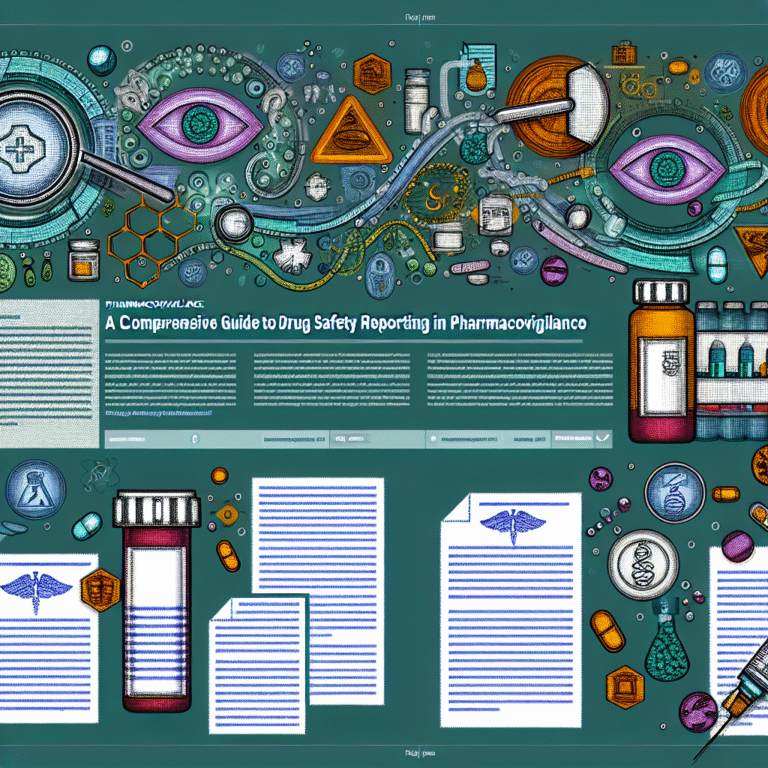The Ultimate Guide to Pharmacovigilance: Protecting Patients from Adverse Drug Events
The Ultimate Guide to Pharmacovigilance: Keeping Patients Safe from Bad Drug Reactions
Introduction
Today, medicine is super important for keeping us healthy. But it’s really important to make sure medicines are safe too. That’s where pharmacovigilance comes in. Pharmacovigilance is all about finding, checking, understanding, and stopping bad effects from drugs or any other drug problems. It’s a big deal for healthcare everywhere. It helps make sure that medicines are used safely so that no one gets hurt.
In this guide, we will learn about pharmacovigilance. It’s for healthcare workers who want to use pharmacovigilance in their work. Whether you have a lot of experience or are just learning, this guide will give you what you need to help keep patients safe.
What is Pharmacovigilance?
Pharmacovigilance is about making patient safety and healthcare better by spotting risks with medicines. It started after things like the thalidomide tragedy in the 1960s and has become very important for public health.
The main goals of pharmacovigilance are to find bad drug reactions (ADRs), reduce drug risks, and use medicines safely and effectively. Its main ideas are being careful, using science, being honest, and always learning.
Around the world, pharmacovigilance helps keep drugs safe, make rules, and make sure drug companies follow safety rules.
Why Pharmacovigilance is Important
Pharmacovigilance is super important for a few reasons:
1. Protecting Patients from Bad Drug Reactions (ADRs): By finding ADRs fast, pharmacovigilance helps stop harm and makes patient care better.
2. Making Drugs Safer and More Effective: Watching drugs closely gives quick info about how safe and effective they are.
3. Following Rules: By following rules from groups like the FDA and EMA, drug companies keep high safety standards.
How Pharmacovigilance Works
Pharmacovigilance uses a step-by-step way to find, study, and lower ADRs. Here’s how it goes:
1. Detection: This means collecting reports of suspected ADRs from healthcare workers, patients, and drug companies.
2. Assessment: Checking the drug and its ADR, looking at things like dose, patient health, and other medicines.
3. Prevention: Putting in tactics to lower risks, like changing doses, adding warnings, or even stopping the drug.
Collecting and managing data is a key part of pharmacovigilance and means healthcare workers, rule-makers, and drug companies working together.
Main Parts of Pharmacovigilance
Adverse Event Reporting:
– Types of Events: Know the different bad events, from mild side effects to serious reactions.
– Reporting Systems: Using ways to report ADRs, both required and optional, well.
– Tools and Methods: Using databases and digital tools for easy reporting.
Signal Detection:
– Signals: Learning to spot big changes in ADR patterns that might mean safety problems.
– Evaluation Techniques: Using stats and health study methods to check signals.
– Technological Tools: Using technology and data to find signals better.
Risk Assessment and Management:
– Risk-Benefit Analysis: Comparing the good and bad of using drugs to help make choices.
– Mitigation Strategies: Creating ways to lower risks, like changing labels and doing more studies.
– REMS Protocols: Putting in strict rules to deal with tough risk situations.
Communication and Education:
– Talking with Patients and Providers: Making sure everyone gets clear info on drug risks.
– Education Programs: Making training to spread knowledge about pharmacovigilance.
– Public Awareness: Helping people understand drug safety better.
Pharmacovigilance Rules
Pharmacovigilance follows strong rules from global groups like the World Health Organization (WHO), U.S. Food and Drug Administration (FDA), and European Medicines Agency (EMA). Knowing these rules is key to keep things safe and follow rules. Different places have different rules, but some groups like the International Council for Harmonisation of Tech Stuff for Medicine (ICH) try to make rules the same everywhere.
Challenges in Pharmacovigilance
Even though it’s important, pharmacovigilance has some problems:
1. Underreporting: Getting more reports from healthcare workers and patients.
2. Data Management: Handling lots of data well and right.
3. Emerging Therapies: Changing rules for new treatments like biological medicine and personal medicine.
4. Resource Constraints: Getting enough money and experts to do pharmacovigilance right.
To solve these issues, we can use more technology, work together, and provide more education and training.
The Future of Pharmacovigilance
Pharmacovigilance is changing a lot thanks to new technology and healthcare needs. Important trends are:
1. Artificial Intelligence and Big Data: These help look at safety data quickly and completely.
2. Patient-Reported Outcomes: Letting patients have a bigger role in saying how their medicine works.
3. Real-World Evidence: Using data from real-world cases to know drug effects better.
4. Global Collaboration: More world teamwork to handle drug safety everywhere.
Case Studies and Success Stories
Looking at real cases teaches us a lot. Some important examples are:
1. Quickly finding and stopping Vioxx because of heart risks.
2. Watching and managing COVID-19 vaccines well.
3. Making new pharmacovigilance plans in low-resource areas.
These stories show how smart pharmacovigilance can make patient safety better and improve health outcomes.
Conclusion
Pharmacovigilance is a main part of modern healthcare, making sure patients get safe and effective treatments. By staying alert and trying new ideas, healthcare workers can help keep patients healthy. Working together is key to making drug safety better. Pharmacovigilance is always changing to meet new needs as time goes on.
Resources and Further Reading
For those wanting to learn more, check these out:
– “Pharmacovigilance: Principles and Practice” by DW Skuse.
– The World Health Organization’s Uppsala Monitoring Centre website.
– Online forums and groups like the International Society of Pharmacovigilance (ISoP).
Keep learning with programs and events about new trends and practices in pharmacovigilance. By learning more and working together, we can make drug safety better and protect patients more.





